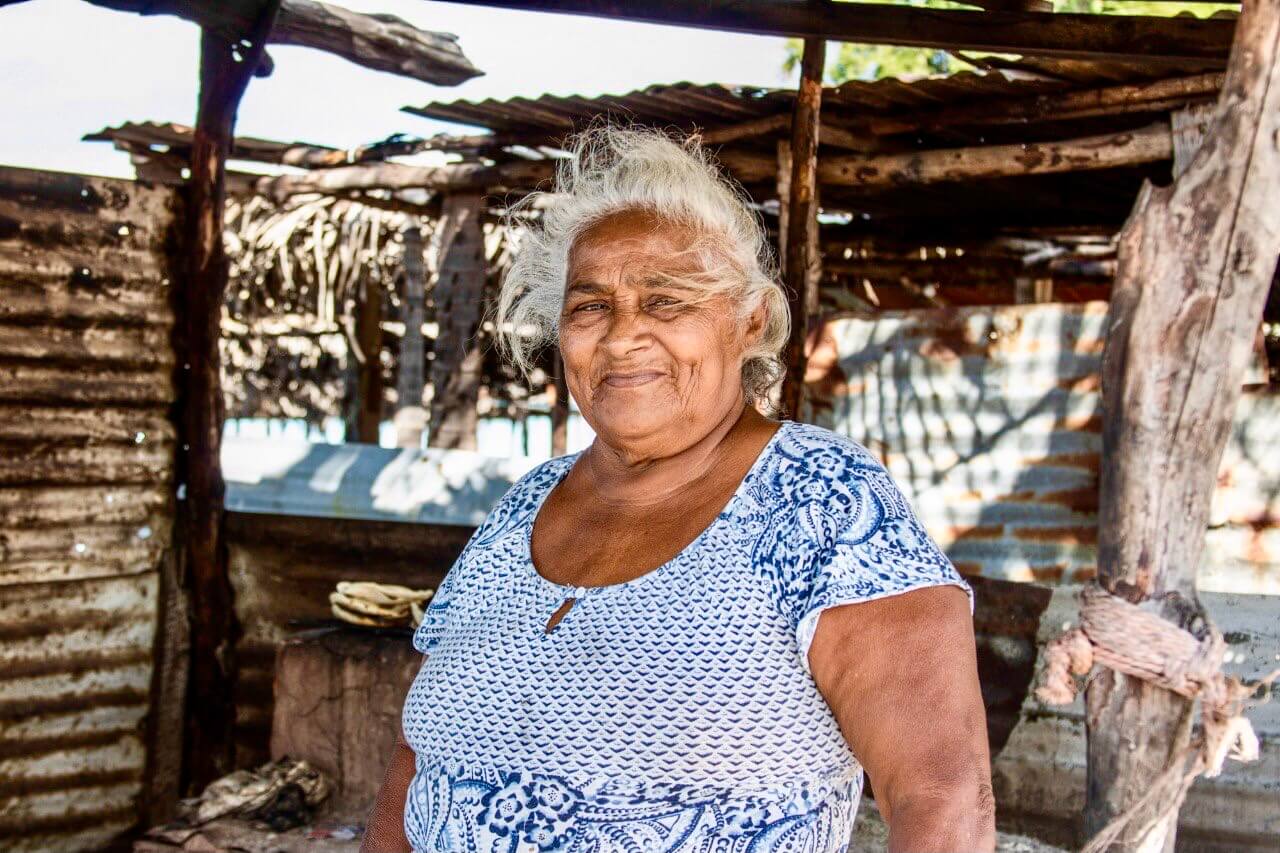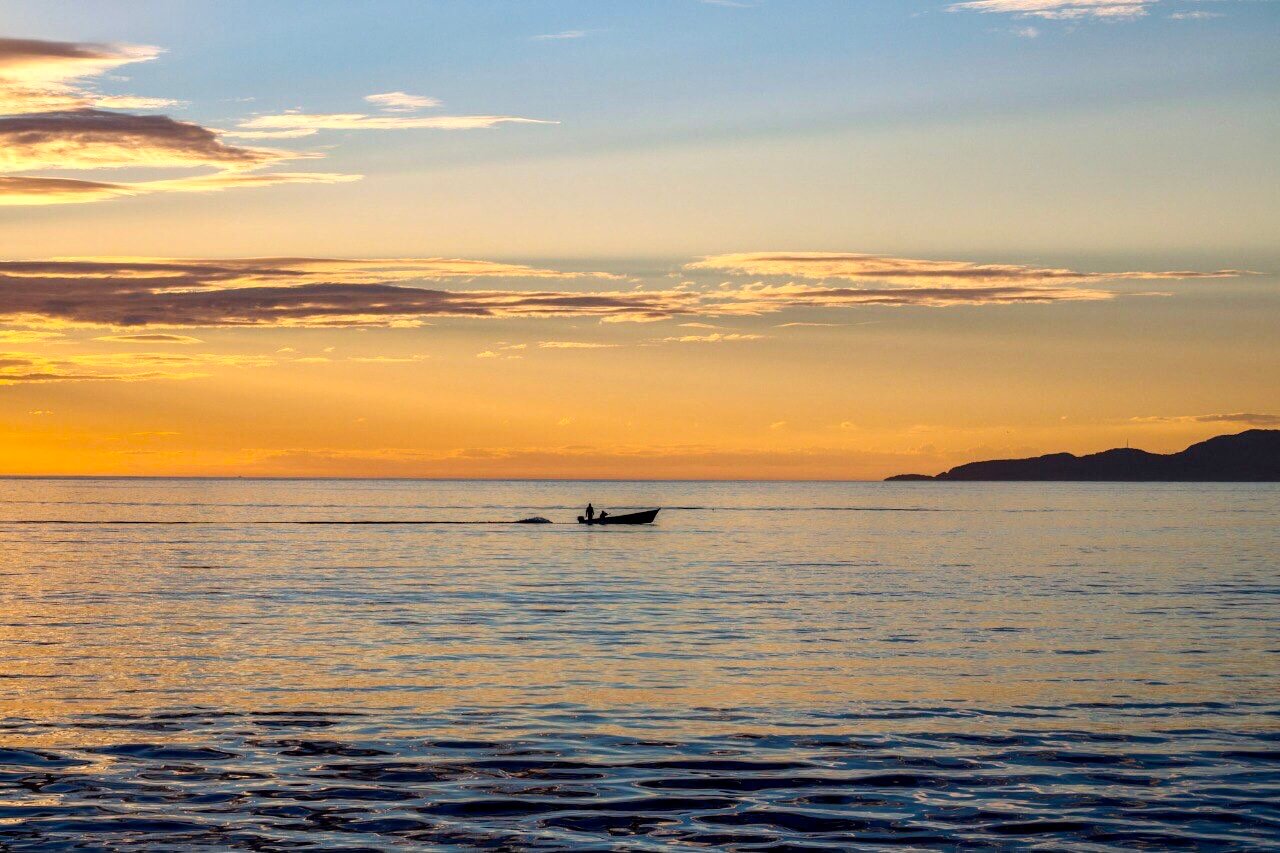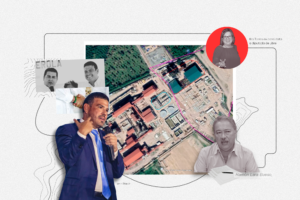The communities in the Dry Corridor of southern Honduras mostly work in the “Coyolito Club” industries: shrimp, sugar cane and melon farming. Companies in these three industries are often the only source of work, but have been accused of human and labor rights violations. They may also be contributing to the environmental deterioration of a region abandoned by its government. All of these factors are driving migrants to flee their homeland.
By María Celeste Maradiaga and Laura García
Photos by Laura García
Adriana Telles and Manuel Lagos have lived together for 36 years. She is from Monjarás, a village in the municipality of Marcovia, and he is from the municipality of Cedeño in Choluteca. They have lived all their lives in the Dry Corridor of southern Honduras, and have watched the sea slowly erode coastal communities like Cedeño.
Adriana and Manuel have made a living digging for black clams, fishing, and selling food along El Edén beach on Honduras’ Pacific coast. Manuel was forced to give up fishing six years ago when the Nicaraguan police confiscated his fishing boat and equipment while enforcing territorial claims during Nicaragua’s ongoing border dispute with Honduras.
Their only other option for survival is to migrate away from their homeland. Manuel and Adriana have three sons: Marvin Manuel, José Luis, and Walter. All three have tried to leave the country. Marvin even managed to make it across the US-Mexico border, but was deported four years ago. Marvin was a fisherman─ one of the best around, say his neighbors. But he had to take all sorts of jobs to make ends meet─ painting, construction, welding, and they weren’t enough.
Marvin and his partner got jobs in the United States, and later bought a house and car. They were sure they would stay there for the rest of their lives. But two years later, “the ‘migra’ got him,” says his mother. Marvin returned to Cedeño alone and took up the only work he could find─ helping other local fishers. “That’s what he does. He goes out every day trying to make a living off the sea. Sometimes he brings home a small catch, sometimes he brings home nothing,” says Adriana.
The family lives in a small wooden home perched on the edge of a lagoon that flows into the Pacific. The water level in the lagoon has dropped severely, and looks more and more like a swamp every year. The community blames local shrimp farms that build dams for the shrimp containment ponds. The gates on the dams have very fine sieves that prevent small shrimp larvae from passing through, but they also severely restrict the outflow of water into the sea.
Juan Angel del Cid Gómez and José David Cáceres are researchers with the Department of Science and Geographic Information Systems at the National Autonomous University of Honduras (Universidad Nacional Autónoma de Honduras – UNAH). Their research indicates that the impacts of climate change and other hydrometeorological phenomena on Cedeño are worsening every year. According to their study, “Villagers are suffering the ramifications: shoreline retreat, flooding from rising sea levels, loss of wetlands, salt water intrusion, and displacement of local inhabitants.”
Their study has documented the flooding of at least 16.2% of Cedeño’s urban area caused by rising sea levels, as well as a tidal wave in 2015 that severely eroded the coastline around Cedeño, damaged infrastructure, and displaced local inhabitants. The discouraging situation led the two researchers to recommend ongoing monitoring of coastal erosion around Cedeño due to greater sea encroachment compared to the beaches of neighboring villages.
Walter, the youngest son of Adriana and Manuel, is rebuilding for the fifth time the small hut on pylons where he lives with his parents. Increasingly intense storm surge in this area frequently destroys homes situated along the seashore. “Everything gets washed away by the sea… only God can help us here,” says Walter.
Environmental impacts on basic grain crops
Southern Honduras has long been affected by climate change. The rainy season is shorter and the harvests of fruits and basic grains have declined. Farmers have stopped farming due to the long drought. Those that still try to “live off corn” go into debt by taking out loans from the Agricultural Development Bank (Banco de Desarrollo Agrícola – BANADESA) that cannot be repaid due to the poor harvests.
The Zacate Grande peninsula in the department of Valle, is one of the most heavily affected areas of Honduras’ Pacific coast. Sorghum crops have disappeared, and watermelons are no longer grown due the crop’s heavy water consumption and a certain insect infestation that can only be eliminated by rain. Sesame crops used in various food products are also declining.
ADEPZA president Abel Perez says that various fruit and basic grain crops are no longer viable in Zacate Grande and other parts of southern Honduras because of climate change, which is forcing people to migrate abroad.
Abel Perez, president of the Association for the Development of the Zacate Grande Peninsula (Asociación para el Desarrollo de la Península de Zacate Grande – ADEPZA), told us how things used to be around here, and noted that farmers now have to pay higher prices for products to fight crop diseases caused by climate change.
“We used to export a lot of watermelons to El Salvador. But Salvadoran buyers don’t want watermelons from Zacate Grande anymore because they are smaller now due to the lack of water,” said Perez, who believes that the area’s biggest problem is water scarcity.
Marcela Isabel Matamoros, a biologist with the Honduran Biologists Association (Colegio de Biólogos de Honduras – CBH) says that people who live in drought-stricken communities often dig their own wells. “Many people in southern Honduras say that their wells have dried up due to the lack of groundwater extraction planning,” said Matamoros. She says that water scarcity sometimes forces local inhabitants to consume salty water, which can lead to health problems like kidney stones.”
Perez says fishing is an endangered occupation in Zacate Grande because it no longer provides enough to live on. The Gulf of Fonseca is Honduras’ outlet to the Pacific Ocean and is flanked by El Salvador and Nicaragua. Water pollution in the gulf has forced entire families to abandon fishing.
Biologist Marcela Matamoros blames the pollution in the Gulf of Fonseca and water scarcity in southern Honduras on the destruction of mangroves by the shrimp farming industry.
“Mangroves are an interface between saltwater and freshwater, a type of filter between these two bodies of water. When mangroves are destroyed, the capacity of this filter becomes weaker and weaker. Gravity and wind then produce saltwater surges that in turn cause freshwater wells to become salty,” said Matamoros.
“Agriculture, the shrimp farming industry, and all their ancillary activities are a delicate subject in southern Honduras because these are export businesses that bring in a lot of money,” she said.
Abel Perez claims that the only alternative for Hondurans living in the area is to migrate if they can’t find work in fishing or with the melon or sugar cane farms that only provide jobs for six months out of the year.
The recent Hernández administration partnered with the United States Agency for International Development (USAID), the Global Agriculture and Food Security Program (GAFSP), and the World Bank to develop the Dry Corridor Alliance (Alianza para el Corredor Seco – ACS). More than US$38 million has been invested in this program over the past five years, which consists of three projects: ACS-USAID, ACS-Prosasur and ACS-ComRural. Each project has a distinct focus, such as poverty reduction, improving food security, and increasing farm productivity and profitability. The stated objective of ACS is to “Reduce poverty and malnutrition through strategic investments in several vulnerable communities in the Dry Corridor of Honduras.” However, Perez and other local residents say that these programs do not really benefit them.
Contracorriente contacted Francisco Posas, Manager of the Rural Competitiveness Project (ACS-ComRural), which is being implemented by INVEST-H, the government’s strategic investment agency. However, we received no response to our requests for an interview about this project and other initiatives.
Industries have failed to stimulate development in southern Honduras
In 2019, Blanca Bonilla left her home in Monjarás for the United States with her youngest son who was only 14 years old at the time. Blanca’s husband, Mauricio, suffers from kidney disease and is unable to work, so Blanca and her son are the household providers. They decided to leave the country for the same reason as everyone else─ to find work. She recalls the ordeal of the journey north when they were captured by the Mexican Federal Police. “I was separated from my son. I could only touch his hand through a plastic barrier,” she says.
Bonilla and ten others in her group were detained by the Mexican police while they were resting. The adults were separated from the children and transferred to cells that the Mexican government reserves for “irregular migrants” coming from other Latin American countries. Mexican immigration officials call them “shelters.” Bonilla said, “The journey is very different from what I expected. They turn out the lights at eight o’clock, and you can’t see if anyone is coming over the top.” The bars between the cells don’t reach the ceiling, and there are no officers at night to watch over the migrants. Bonilla was terrified thinking about the risk of being raped in the “shelters.”
The cost to emigrate from Honduras is high. Some sell their houses and cars, whatever they own to pay for the journey to the United States. Others take out loans. Every migrant believes they can make it all the way. But when they fall short and have to return home, says Bonilla, “the feeling of despair is the worst, because you leave here with lofty goals.”
According to the 2018 census conducted by the National Institute of Statistics (Instituto Nacional de Estadística – INE), 58% of the people in the municipality of Marcovia work in agriculture, livestock, forestry, and fishing. This includes the Marcovia residents who work in local melon, shrimp, and sugarcane farms, which are temporary jobs during the planting and harvesting seasons.
Suany Arriola had a similar experience. The 26-year-old mother tearfully remembers her 2019 trip to the United States with her six-year-old son. “It was hard. We had to travel day and night, and the little food we carried wasn’t enough,” she said. They left from Marcovia and made it to the Mexican border in a month, thene they were detained by Mexican immigration authorities. She waited there with her son for another month until enough migrants were detained to fill two buses for deportation. Suany acknowledges that she risked her life migrating north, but without a stable job or any income, she felt she had no choice.
Suany recently tried again to migrate when she was two months pregnant. Her health deteriorated in Chiapas, Mexico, and she almost lost her baby. “The doctor told me that to continue would be very risky for my pregnancy, so I told him that I’d return home,” she said. She went back to Honduras accompanied by her sister, who was also trying to make it to the United States. Her brother-in-law kept going, only to be deported later to Honduras.
“I tell Suani, ‘You’re staying behind now.’ It’s my turn to try. I have faith in God that I’ll make it [to the United States], because I’m older and more experienced,” said Suany’s 44-year-old mother, María Rosa Ramos.
María Rosa is originally from Choluteca and came to Marcovia 23 years ago looking for a house to rent. She has nine children, and Suany is the only one of her six children with her first husband still living with her.
“I tell Suany not to worry. Even though we have nothing, God will provide. She cries about it because she already has two children and a third on the way. But her father left me with six children when he died and here they are. They could only attend school through the sixth grade because paying for education is hard,” says María Rosa as Suany bursts into tears.
María Rosa told us that she worked briefly for a melon farm, which is a common practice in this industry because of its need for temporary workers during the planting and harvesting seasons. She doesn’t look very happy when we ask her about her experience at the melon farm.
Job opportunities are increasingly scarce in Marcovia and the southern communities of Honduras, where the choices are to work for melon, sugar, and shrimp farms, or as a bricklayer’s assistant. These are the same industries that are being accused of human and labor rights violations.
Tomás Membreño is president of the national farmworkers’ labor union (Sindicato de Trabajadores de la Agroindustria y Similares – STAS), and has closely followed cases in southern Honduras of labor exploitation and human rights violations. In an interview with Contracorriente, Membreño talks about Suragrícola de Honduras (Suragroh), a melon farm in southern Honduras owned by Fyffes, a Japanese fruit and fresh produce company based in Dublin, Ireland.
Fyffes is one of the six largest fruit companies in the world. Its Honduran operations include the Suragroh and Melon Export melon farms. Its products are marketed in the United States by Fyffes or Sol Group Marketing, and bear the Fair Trade Certified seal. This certification enables them to fetch a better price for their fruit. However, this changed after human rights violations against Honduran workers were widely reported. In 2016, workers decided to take legal action against Suragroh, but the company retaliated with layoffs, said Membreño.
“A group of about 300 workers had already decided to sue the local company when an international complaint was filed in 2016 after violations of human and labor rights were confirmed by the Ministry of Labor. International commissions came to verify the facts and discovered that the company fraudulently secured their Fair Trade Certification despite all the labor complaints,” said Membreño. This led to Fyffes losing their Fair Trade Certification.
The Japanese transnational company initiated an effort to clean up its negative image around the world. “Fyffes allowed two unions to organize the Suragroh and Melon Export workers to improve its international image. But all the facts and documentation that were revealed didn’t help their cause, and they are still uncertified because of their human and labor rights violations,” says Membreño.
When the Fair Trade Institute sent an evaluation commission to conduct audits in Honduras, it found violations in melon worker pay, health, and freedom of association rights. The Fair Trade Institute subsequently sanctioned the melon companies by withdrawing their certification. They were also expelled from Europe’s Ethical Trading Initiative in collaboration with the International Labor Organization (ILO).
A video from the Federation of Agribusiness Labor Unions (Federación de Sindicatos de Trabajadores de la Agroindustria – FESTAGRO), a national association of labor unions of which STAS is a member, explains why Fyffes was decertified and sanctioned, and its website reports many denunciations by melon farm workers in southern Honduras, statements by international organizations on the issue of Fyffes certification, and other content related to union struggles in the Honduran agribusiness sector.
“One of the main problems here is that workers don’t have any health care benefits. Some 7 to 10,000 people harvest melons during the season, and 95% of them are temporary workers, which is why their employers say they don’t qualify for social security,” said Membreño.
Tomás Membreño, president of STAS, says that one of the main problems of melon farm workers in southern Honduras is that 95% of them are temporary workers that don’t qualify for social security.
Membreño says that because they are temporary workers, they don’t receive any severance after five or six months of work, nor are they given any protective equipment when they use chemicals in the melon fields. The employers are morally obliged to do so, and it’s also a requirement of the international markets in which they participate.
Contracorriente requested an interview with SURAGROH’s management, but received no response.
Tomás Membreño says that something similar is happening in the sugar cane plantations and mills that mostly employ temporary workers in southern Honduras. One of the most well-known mills is Azucarera La Grecia, which is owned by the Honduran Sugar Producers Association (APAH). This mill has been accused by its workers of denying their right to freedom of association and of various human and labor rights abuses. Membreño says that a complaint was filed in 2012 and that the Honduran government has been incapable of resolving any of the worker abuse cases cited in the complaint.
Lorena Rodríguez Rico, the public affairs manager for Azucarera La Grecia, replied by email to Contracorriente’s written questions, saying that La Crecia is one of the largest employers in southern Honduras and provides jobs for around 5,000 people, 900 of whom are permanent employees. These jobs “provide a decent living for thousands of families,” said Rodriguez, “and enable them to find other opportunities in their communities and country.” She did not address our questions about the worker abuse complaints.
To our questions about the sugar company’s environmental policies and toxic waste management, Rodriguez replied that their operations are regulated by the Ministry of Natural Resources and the Environment (MiAmbiente), and that they are implementing a composting project that could reduce the use of chemical fertilizers. She stated La Grecia is an environmentally responsible company and that it manages its by-products and toxic waste “in compliance with Honduran law, and specifically with each and every waste disposal standard established by the Municipal Environmental Protection Unit (Unidad Municipal del Medioambiente – UMA). Azucarera La Grecia’s commitment to the environment is a fundamental corporate value, which is why we work hard to comply [with the law]. We try to leave the planet a little better than we found it.”
“The employees and workers of these companies know about the pollution, but this is their only source of work,” says ADEZPA’s Abel Perez. He says these companies are not monitored by any government agency, such as MiAmbiente or the Forest Conservation Institute (Instituto de Conservación Forestal – ICF).
“When the Gulf of Fonseca was polluted and all the mollusks died, MiAmbiente and the ICF never conducted an investigation to determine the source of the pollution. We don’t know what killed off the mollusks and the authorities won’t provide us with any information about this. In other words, they’re not interested,” says Perez.
The pollution in the Gulf of Fonseca comes from the Nacaome River, which flows through the Department of Valle’s melon, sugar cane and shrimp farms, and empties into the Gulf. These farms all use chemicals on their crops and consume a great deal of water for irrigation. But they are also the largest employers in the area.
Contracorriente contacted MiAmbiente for an interview several times before and after the January change in government, but our requests were denied or unanswered.
Zacate Grande’s “Coyolito Club”
Ethel Verónica Corea fishes for a living in Zacate Grande, which is unusual according to Abel Perez, because most of the women in the area work at gathering mollusks. Corea is 41 years old and actively collaborates with ADEPZA, a regional development association, in its efforts to protect the Zacate Grande community.
“The community first established ADEPZA, and then we created a women’s group within ADEPZA since we are in charge of our homes and know everything that goes on there. We are also mothers, and those who are migrating abroad are our children, our young people,” said Corea.
Forced migration is a principal reason for the creation of the Women’s Network of the Municipality of Valle. Corea meets with this group that analyzes proposals and presents solutions to the community, but also functions as an empowerment and support network for local women. “We want this group of women to be empowered to protect our land,” said Corea.
Corea served eight years of alternative detention for the crime of land usurpation. She blames Miguel Facussé, son of the deceased Miguel Facussé Barjúm, one of the country’s most important business figures, for her criminalization. Facussé is the largest landowner in the Zacate Grande peninsula, according to locals. She and her husband, who was convicted of the same crime, had to check in with the authorities every day from 2007 to 2013.
In 2010, a confrontation between the police and villagers left her with a scar on the upper left side of her forehead. “One of Facussé’s workers shot me in the head with a BB gun because I told him to stop trampling the corn. It costs a lot of money to grow corn to live on. Everyone saw him shoot me, so they beat him up,” said Corea.
This wasn’t the only instance of intimidation. Corea says they have surveillance systems and have even trespassed on her property. “I fought back by putting up this fence since I kept finding their boot prints in the dirt around our house,” she said. Every time she files a complaint, the authorities tell her to “stop going around fighting for land that’s not yours.”
Corea is not the only victim of intimidation in her family. Her two eldest sons were forced to flee the country and emigrate to the United States. When we asked about her sons and their lives in the United States, Ethel began to cry. She told us that her youngest son was recently attacked by gang members. “What gang do you belong to?” was the only question they asked before shooting him six times.
“The family breakups are awful. I didn’t want my children to leave, but they were being oppressed by the military. They just picked up and left one day, without a coyote or anything. A month later they were already there and had jobs,” said Corea. Her 20-year-old daughter is thinking about migrating to the United States because of the lack of opportunity in the Zacate Grande peninsula.
Abel Perez and Ethel Corea say that Xiomara Castro’s election victory brought a measure of hope to the Zacate Grande community. None of the development projects touted by the Hernandez administration benefitted them. Perez says, “‘The program never happened─ they only put up some roadside signs,” adding that the aid announced by the United States Agency for International Development (USAID) never arrived either.
Migrants from other countries are scattered around southern Honduras
Karla Escoto is a migration specialist with the Red Cross’s Expanding Opportunities in the Southern Zone Project (Proyecto Ampliando Oportunidades Zona Sur – PAO-Sur) in Choluteca. An initiative with similar objectives called the Monarch Butterfly Project used to provide services in the area. PAO-Sur supports migrants in southern Honduras that are in transit or that have suffered from violence of any kind.
“With the steady flow of migrants that exists now, we provide assistance to 30-50 people a day,” says Escoto. There are not many other migrant assistance programs in the area. The Red Cross works with Hope House (Hogar de la Esperanza), a project run by the Catholic Church that provides lodging, medicine and food to Honduran and foreign migrants.
Migrants entering Honduran territory through Choluteca must pay US$200 to the government migration office for “irregular migration.” Escoto says this is why “migrants in transit are entering Honduras at El Paraíso. They aren’t charged a fee over there.”
Read (in Spanish): The Haitian exodus passes through Honduras
The government’s fee for irregular migrants is why Marvin, a Nicaraguan citizen, has been stuck in Honduras for two weeks trying to raise the money to continue his journey after fleeing his country out of fear. He is a nurse by profession but had to leave Nicaragua to get the second COVID vaccine dose even though he is a front-line health worker. He is also one of the thousands of politically persecuted Niacarguans. “I left for disagreeing with the regime… you can’t do that there. I’m just looking for a safe place,” said Marvin.
In 2018, Nicaragua was swept by demonstrations demanding the resignations of Daniel Ortega and his wife, Rosario Murillo, who has been her husband’s vice president since 2017. The demonstrators were protesting a corrupt dictatorship riddled with nepotism, and 328 people died when the protests were violently repressed, according to the Inter-American Commission on Human Rights (IACHR). Over 100,000 Nicaraguans soon fled into exile.
Marvin comes from an area where many people are fleeing the ongoing crisis. But life in Honduras is not very different from life in Nicaragua, due to the autocratic regime and increasing poverty that has gripped the nation for the last 12 years.
Reports issued by the Red Cross reveal that migration abroad increases during times of drought in southern Honduras. The flow of migrants increases during October, November and December, about the time when the sugar, melon, and shrimp farms lay off their field workers. Those who can’t find work during these months often decide to go to northern Honduras to work in the foreign-owned export factories. And if they can’t find work in the industrial north, they migrate to the United States or Spain.
***
“Some aid does make it here, but it’s doled out selectively. It’s not spread evenly. Fishers need fish─ we’re all hungry,” says Adriana when we ask her about aid programs for people in Cedeño. Nowadays, she says that the fishermen only go out to “strain water” through their nets every day because there are no fish.
We ask Adriana and her husband, Manuel, why the situation in the Gulf of Fonseca has deteriorated. They blame the people who own big businesses in southern Honduras that pour polluting chemicals into the sea. They also blame the shrimp farms for preventing larvae from flowing from the estuaries into the sea, larvae that feed the fish that have disappeared.
“They’re killing the Gulf,” says Adriana, as she fries sliced green bananas to sell on the beach. “Sometimes we can serve up a plate of fried fish, and sometimes we can’t,” says Manuel.














